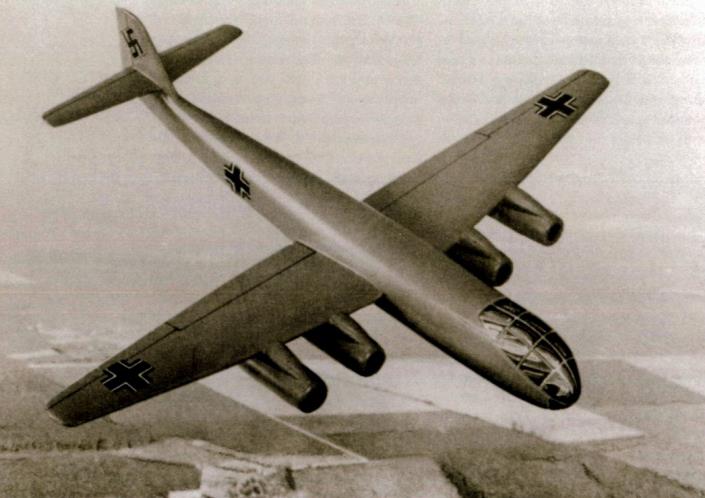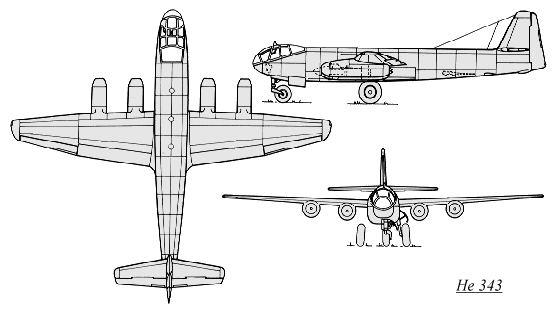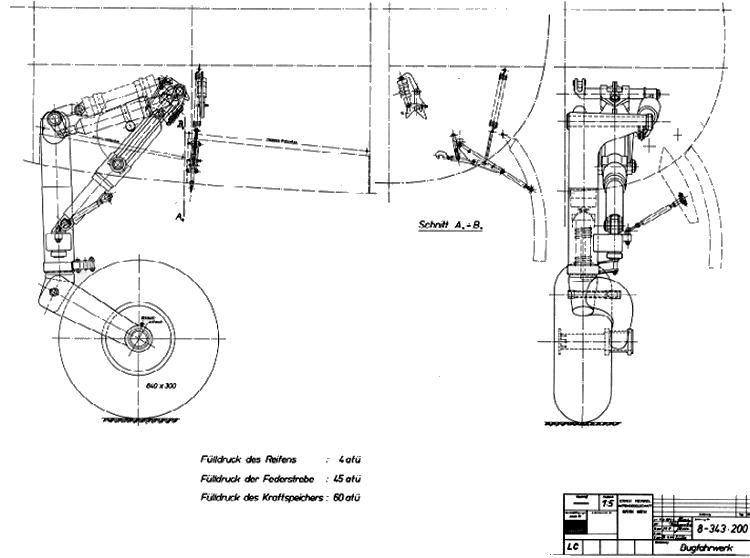| Type |
A Two seat bomber |
B Two seat bomber |
| Engine |
4 Jumo 004C |
4 Heinkel HeS 011A |
| Dimensions |
Length 16,5 m , height 5,35 m , span 18 m , wing area 42,45 m2 , |
Length 16,5 m , height 5,35 m , span 18 m , wing area 42,45 m2 , |
| Weights |
Empty 5260 kg, loaded 17945 kg , max. take off weight |
Empty , loaded 18475 kg , max. take off weight |
| Performance |
Max.. speed 825 km/h at sea level, 835 km/h at 6000 m, 770 km/h at 10000 m, cruising speed 730 km/h at 11100 m , landing speed 168 km/h, range 1620 km km, endurance , service ceiling 12200 m , climb to 6000 m 8,9 min., to 10000 m 18,6 min. |
Max.. speed 910 km/h at sea level, 890 km/h at 6000 m cruising speed , landing speed 173 km/h range 1880 km, endurance , service ceiling 15000 m , climb to 6000 m6,0 min., to 10000 m 13,1 min.
|
| Armament |
2 20 mm MG 151/20 with 200 rounds Bombload 2000 kg |

Work on what would become the He 343 commenced during January 1944. That same month, the German aircraft manufacturers Heinkel and Junkers were both personally approached by Siegfried Knemeyer, the Head of Technical Development at the Government Air Ministry (Reichsluftfahrtministerium), with a request to develop a four-engined jet-powered bomber as a "crash" programme with a short development window of roughly one year.[ By that point, Heinkel had already played a key role in pioneering jet propulsion during the 1930s, and was keen to develop combat-ready jet-powered aircraft that would be procured in large numbers to meet the wartime needs of the Luftwaffe.
Accepting this request, Heinkel quickly designed a four-engined bomber with unswept wings that were attached at the center of the fuselage. It was to be operated by a crew of two, who were seated within a pressurised glazed cockpit at the front of the aircraft; an optional third crew member may have also been carried for some mission roles. The engines, which were individually mounted beneath the wings, could alternatively be Junkers Jumo 004, BMW 003, or Heinkel HeS 011 powerplants. Armaments and/or equipment were to be carried both internally and externally; while up to 2,000 kg of bombs could be accommodated within the bomb bay, the bomb racks underneath the wings would have provided additional mounting points. Defensive armaments include a pair of fixed rear-facing MG 151 20mm cannons, which were installed within the fuselage.
Operationally, it was to be faster than previous peers as to better evade interception, and flexible enough to perform alternative roles such as aerial reconnaissance and fighter-bomber duties; pursuing compatibility with multiple turbojet engines also reduced some of the potential manufacturing difficulties. To shorten its development, considerable attention was paid to the existing Arado Ar 234 jet bomber; to this end, design information was supplied by Arado and the Deutsche Forschungsanstalt für Segelflug (DFS) to Heinkel.
From at early stage, four distinct models of the aircraft were planned. The He 343 A-1 was a dedicated bomber variant. Amongst the munitions it was intended to carry was the Fritz X guided Anti-ship glide bomb, which would have been radio controlled from the aircraft by a third crew member. The He 343 A-1 was very similar to the He 343 A-2, the variant intended for reconnaissance missions. For extended endurance, an additional 2,400 kg of fuel could be carried in an additional tank in the bomb bay instead of munitions; a pair of Rb 75/30 cameras would have been used for photo reconnaissance. The He 343 A-3 was envisioned for battlefield support, being armed with a pair of MG 151 20mm cannons in addition to four forward-firing MK 103 30mm cannons mounted with its bomb bay. The He 343 B-1 also performed the same role as the He 343 A-3, differing in terms of the armament used, having an upgraded rear turret arrangement that necessitated the redesign of the tail unit.
The Air Ministry reviewed Heinkel's proposal, as well as a competing design produced by Junkers.[6] While the Air Ministry did place an initial order for 20 aircraft, which included the prototype and pre-production units. The company's founder, Ernst Heinkel, personally lobbied in favour of the project, pointing to its simplicity, lower material cost, and more rapid development schedule.[6] It was claimed that as many as 200 He 343s could be supplied by July 1945.[7] The DFS designated the project P.1068. However, during late 1944, Heinkel was ordered to stop all work on the programme and the order was cancelled.[6] This outcome came as a consequence of Germany's deteriorating position in the conflict and to refocus limited resources onto efforts such as the Emergency Fighter Program. The aviation author Daniel Uziel claimed that German authorities had probably wanted Heinkel to concentrate on producing the Heinkel He 162 fighter instead.
While no aircraft were ever completed, much of the design work had been completed and a substantial amount of components for the project had already been produced.[8] The incomplete airframes and components were initially stored by Heinkel in the hope that the project would be resumed. As the conflict approached its conclusion in 1945, the Allied powers sought to obtain whatever technical information that could be recovered from Nazi Germany, particularly on its advanced military projects and aerospace initiatives. The Soviet Union succeeded in acquiring much of the He 343's design and components from Heinkel's facility in Schwechat, outside Vienna. Thereafter, it is alleged that the project served as the basis for the development of the Ilyushin Il-22, albeit with some of the parameters being altered, such as the size and crew numbers. A single prototype was built and flown. The results of these tests were used in development of the Ilyushin Il-28.

Although the RLM sanctioned 20 total He 343 aircraft (including prototype and pre-production examples),(Wnr. 850061- 860080) they were never very enthusiastic about Heinkel's four jet bomber. Plus, the He 343 was in a battle for a contract with Junkers' forward swept wing 287, also a four jet bomber. Professor Heinkel went so far as to write a very opinionated letter to the RLM, touting the 343's quicker development time, lower material cost and basic simplicity, but it was to no avail. The He 343 program was stopped in late 1944*, and all finished components and construction jigs were either put into storage, or scrapped, due to the worsening war situation, in which all aircraft construction was to be concentrated on fighter aircraft.
*Some sources state that a prototype He 343 was completed, but was either destroyed in a bombing raid or was scrapped before the first test flight.



